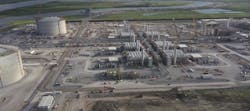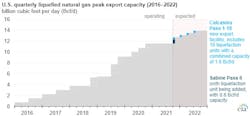US LNG export capacity to become world's largest by end 2022
US liquefied natural gas (LNG) export capacity has grown rapidly since the Lower 48 states first began exporting LNG in February 2016. In 2020, the US became the world’s third-largest LNG exporter, after Australia and Qatar. Once the new LNG liquefaction units (trains) at Sabine Pass and Calcasieu Pass in Louisiana are put into service by end 2022, the US will have the world’s largest LNG export capacity, the US Energy Information Administration (EIA) said.
According to announced project plans, the following newly added LNG export capacity will come online by end 2022:
- Train 6 at the Sabine Pass LNG export facility. Train 6 will add up to 0.76 bcfd of peak export capacity. It began producing LNG in late November. The first export cargo from the train is expected to be shipped before end 2021.
- Calcasieu Pass LNG. Venture Global LNG’s new export plant has 18 liquefaction trains with a combined peak capacity of 1.6 bcfd. Commissioning activities at Calcasieu Pass LNG started in November 2021. First LNG production is expected before yearend (OGJ Online, Mar. 22, 2021). All liquefaction trains are expected to be operational by end 2022.
The nameplate, or nominal, capacity of a liquefaction plant specifies the amount of LNG produced in a calendar year under normal operating conditions, based on the engineering design of a facility. Peak LNG production capacity is the amount of LNG produced under optimal operating conditions, including modifications to production processes that increase operational efficiency.
In October 2021, the US Federal Energy Regulatory Commission (FERC) approved requests to increase authorized LNG production at the Sabine Pass and Corpus Christi LNG terminals by a combined 0.7 bcfd. The terminals will achieve these increases by optimizing operations, including production uprates, and modifications to maintenance.
As of November 2021, EIA estimates that US LNG nominal liquefaction capacity was 9.5 bcfd and peak capacity was 11.6 bcfd. This peak capacity includes uprates to LNG production capacity at Sabine Pass and Corpus Christi.
By the end of 2022, US nominal capacity is expected to increase to 11.4 bcfd, and peak capacity will increase to 13.9 bcfd, exceeding capacities of the two largest LNG exporters, Australia (which has an estimated peak LNG production capacity of 11.4 bcfd) and Qatar (peak capacity of 10.4 bcfd). In 2024, when construction on Golden Pass LNG—the eighth US LNG export plant—is completed and begins operations, US LNG peak export capacity will further increase to an estimated 16.3 bcfd.

